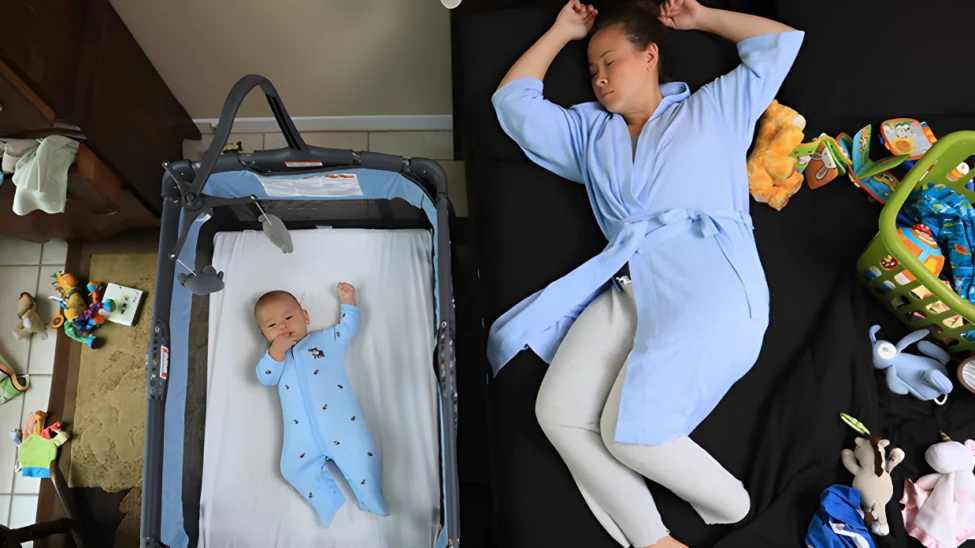
Why the crib’s location matters more than you think
The crib isn’t just another piece of furniture. Where it stands will shape your baby’s sleep and your peace of mind. I’ve had many parents tell me, “We didn’t think twice about where we put it. It fit in that spot, so we left it.” And then they were up half the night adjusting blinds, unplugging night lights, or even moving the whole crib at 2 a.m.
A well-placed crib protects your baby not just from bumps or bruises but from environmental factors we often overlook — drafts, too much sunlight, or even curious siblings. It’s also the first step in building a sleep routine that’s calm and predictable. When the crib is in a space that feels safe, your baby feels that too.
It’s not just about aesthetics. Where your baby sleeps influences how they sleep.
What should stay far away from the crib
Let’s be honest — even a beautifully decorated nursery can hide dangers. Cords from blinds, outlets, heaters, wall decorations, baby monitors, and even a heavy picture frame can all pose a threat if placed too close to your baby’s sleeping area.
One mom I worked with had a stunning mobile hanging right over the crib. It looked adorable — until it started swaying too close as her baby grew and began reaching for it. A well-placed crib doesn’t just avoid obvious risks; it also takes into account how your baby will develop over the next few months.
- Keep the crib away from windows (sunlight, cords, and drafts)
- Avoid placing the crib near radiators or heaters
- Don’t hang heavy decor above the crib
- Keep cords, chargers, and monitors at a safe distance
If it can fall, swing, or be pulled — it doesn’t belong near the crib.
Light, airflow, and noise — small details, big impact
Let’s talk about what you might not see but your baby definitely feels. A crib placed right next to a window might seem like a good idea for natural light, but if your baby is waking at dawn every day, you’ll quickly wish it wasn’t. On the flip side, being too close to a door or hallway can mean they’re constantly disturbed by noise or movement.
There’s also the matter of airflow. A soft breeze may seem harmless, but repeated exposure to drafts can make sleep less restful. I once worked with a family whose baby woke every night at 3 a.m. After some detective work, we realized the crib was directly under an air vent. Moving it one meter changed everything.
So pay attention to where the light hits during naps, where the cold air flows at night, and how much noise comes from the hallway or even the baby monitor itself.
Where I put the crib in my own home
When we brought our daughter home, I thought I had the nursery perfectly planned — crib by the window, cute pictures above, a reading nook nearby. But within a week, I knew something wasn’t right. She’d squint from the sunlight during daytime naps, and I’d panic every time I saw her little hands stretch toward the curtain cords.
So I moved everything. The crib ended up against a solid wall, away from windows and outlets. I added blackout curtains and shifted her changing table to the brighter corner. Suddenly, naps stretched longer, and bedtime went smoother. I didn’t expect such a dramatic difference, but I’m glad I paid attention to how the space made her feel.
Sometimes the most comfortable arrangement isn’t the most obvious one.
Thinking ahead: baby growth and nighttime routines
One thing we often forget in the early days is how fast babies grow — and how quickly they start pulling up, standing, and getting curious. That cute corner next to the shelf might be fine for a newborn, but not for a nine-month-old who suddenly wants to reach for everything.
You’ll also want to think about your own night routines. Is the crib easily accessible when you’re half-asleep at 3 a.m.? Can you reach it without bumping into furniture or making too much noise? Is there a nightlight nearby but not directly shining in your baby’s eyes?
The way you use the room will change, so placing the crib with flexibility in mind can save a lot of rearranging later. And when it’s done right, everyone — not just baby — sleeps better.
Crib placement is like setting the stage for your baby’s rest. Quiet, dark, safe, and reachable — that’s the sweet spot.
What stays with you
A well-placed crib isn’t just safe — it makes sleep feel welcome.
Once you’ve got the crib in the right place, it’s one less thing to worry about. You’ll be surprised how much calmer bedtime feels when the space supports rest instead of distracting from it. You don’t need a perfect Pinterest nursery. You just need one that works for your baby — and for you.
If you’re still unsure, try lying down in the crib’s planned spot for a few minutes. Is it peaceful? Is it drafty? Would you want to sleep there? That’s usually all the answer you need.


